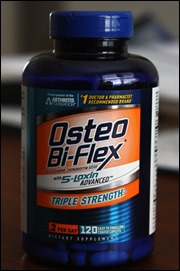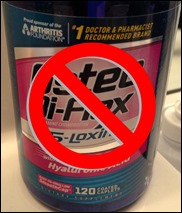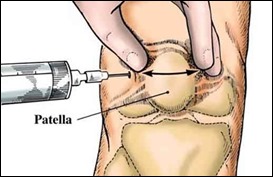Layman advice: Contemplating the options for knee pain
Posted By RichC on March 26, 2013
Far be it from me to offer up medical advice … as I’m not a doctor nor do I play one on the Internet, but I have found a few solutions that seem to help Osteoarthritis (OA) and  the associated stiffness and pain coming from my knee.
the associated stiffness and pain coming from my knee.
A little bit of history: Ten years ago, I complained to my primary care physician that my knee was bothering me. I had already tried a few over the counter items, Ibuprofen, ice, heat and self-directed physical therapy. Also the long drives in a firm seated car (my leather seat VW Jetta TDI) exacerbated the pain and stiffness to the point I eventually sold the car due to leg-nerve pain … although I’m not positive it was entirely related to my knee. For the record, before giving up my little diesel, I did try a variety of seat cushion options … only the larger and more upright seat in our old minivan and Honda Pilot improved the condition.
In 2008, I saw an orthopedic surgeon to get his opinion. He looked at the MRIs and commented to me that “because I’m a surgeon, I cut.” His point being is that knee surgery is not something to rush into, but that is what he does and that he would be able to “clean things up.” We … well, I … decided to put off the inevitable for a while since joints wear and even I were to have surgery, I might still end up back to see him in another ten or so years for a redo or even knee replacement surgery (no thanks).
So … I opted for the recommended Cortisone steroid injections for  the immediate pain and then would try to baby my joints a little bit. The Cortisone shot was a miracle short term cure and helped me make it through my son’s high school graduation and following summer. I returned to active movement and almost all the daily activities I wanted to do (unfortunately steroid shots are not something you want – or can — do all that regularly).
the immediate pain and then would try to baby my joints a little bit. The Cortisone shot was a miracle short term cure and helped me make it through my son’s high school graduation and following summer. I returned to active movement and almost all the daily activities I wanted to do (unfortunately steroid shots are not something you want – or can — do all that regularly).
Next was was to figure out how to stay pain and stiffness free in order to put off the inevitable. Strengthening muscles helps, but lots of bending and loading of the joint doesn’t; a stiff/sore knee returned and by 2009 I started looking at dietary supplements. I added glucosamine and chondroitin in the morning and evening (not cheap or medically conclusive according to several studies), but it does seem to make a difference from a patient’s perspective. In other words, people who takes glucosamine says it helps, but blind testing with placebos does not conclude there is a medical improvement. (LINK)
In a follow-up study, 572 patients from the GAIT trial continued their supplementation for 2 years. After 2 years of supplementation with glucosamine and chondroitin sulfate, alone or in combination, there was no benefit in slowing the loss of cartilage, in terms of joint space width, when compared to a placebo.
 What I have concluded is that taking the “triple strength” glucosamine supplement Osteo-Biflex seems to help … and the orange labeled bottle (triple strength – 2 tablets/day) seems better than the pink bottle (MSM – 4 tablet/day) after switching back and forth.
What I have concluded is that taking the “triple strength” glucosamine supplement Osteo-Biflex seems to help … and the orange labeled bottle (triple strength – 2 tablets/day) seems better than the pink bottle (MSM – 4 tablet/day) after switching back and forth.
Here’s my non-medical advice if you have aging knees (joints) before rushing into surgery … take it for what it is worth:
- See an orthopedic surgeon and have him review your MRI
- Consider a Cortisone shot to get over the short term pain
- Strengthen your muscles around your joint – lose a few pounds (knee)
- Add glucosamine and chondroitin as a daily supplement (don’t expect an immediate improvement and stay with it)
- Be smart in how you use your knees and joints – don’t abuse them
Clinical studies have consistently reported that glucosamine appears safe. However, a recent Université Laval study shows that people taking glucosamine tend to go beyond recommended guidelines, as they do not feel any positive effects from the drug. Beyond recommended dosages, researchers found in preliminary studies that glucosamine may damage pancreatic cells, possibly increasing the risk of developing diabetes.[29]
Adverse effects, which are usually mild and infrequent, include stomach upset, constipation, diarrhea, headache and rash.[30]
Since glucosamine is usually derived from the shells of shellfish while the allergen is within the flesh of the animals, it is probably safe even for those with shellfish allergy.[31] However, many manufacturers of glucosamine derived from shellfish include a warning that those with a seafood allergy should consult a healthcare professional before taking the product.[32] [33] Alternative, non-shellfish derived forms of glucosamine are available.[34][35]
Another concern has been that the extra glucosamine could contribute to diabetes by interfering with the normal regulation of the hexosamine biosynthesis pathway,[12] but several investigations have found no evidence that this occurs.[36][37][38] A manufacturer-supported review conducted by Anderson et al. in 2005 summarizes the effects of glucosamine on glucose metabolism in in vitro studies, the effects of oral administration of large doses of glucosamine in animals and the effects of glucosamine supplementation with normal recommended dosages in humans, concluding that glucosamine does not cause glucose intolerance and has no documented effects on glucose metabolism.[39] Other studies conducted in lean or obese subjects concluded that oral glucosamine at standard doses does not cause or significantly worsen insulin resistance or endothelial dysfunction.[40][41][42]


Comments